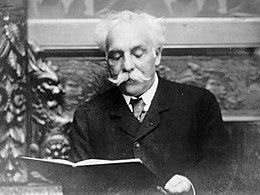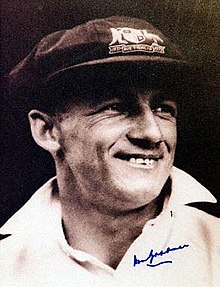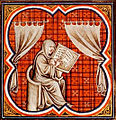Portal:Biography
The Biography Portal
A biography, or simply bio, is a detailed description of a person's life. It involves more than just basic facts like education, work, relationships, and death; it portrays a person's experience of these life events. Unlike a profile or curriculum vitae (résumé), a biography presents a subject's life story, highlighting various aspects of their life, including intimate details of experience, and may include an analysis of the subject's personality.
Biographical works are usually non-fiction, but fiction can also be used to portray a person's life. One in-depth form of biographical coverage is called legacy writing. Works in diverse media, from literature to film, form the genre known as biography.
An authorized biography is written with the permission, cooperation, and at times, participation of a subject or a subject's heirs. An autobiography is written by the person themselves, sometimes with the assistance of a collaborator or ghostwriter. (Full article...)
Featured biographies –
William T. Anderson (c. 1840 – October 26, 1864), known by the nickname "Bloody Bill" Anderson, was a soldier who was one of the deadliest and most notorious Confederate guerrilla leaders in the American Civil War. Anderson led a band of volunteer partisan raiders who targeted Union loyalists and federal soldiers in the states of Missouri and Kansas.
Raised by a family of Southerners in Kansas, Anderson began to support himself by stealing and selling horses in 1862. After a former friend and secessionist turned Union loyalist judge killed his father, Anderson killed the judge and fled to Missouri. There he robbed travelers and killed several Union soldiers. In early 1863 he joined Quantrill's Raiders, a group of Confederate guerrillas which operated along the Kansas–Missouri border. He became a skilled bushwhacker, earning the trust of the group's leaders, William Quantrill and George M. Todd. Anderson's bushwhacking marked him as a dangerous man and eventually led the Union to imprison his sisters. After a building collapse in the makeshift jail in Kansas City, Missouri, left one of them dead in custody and the other permanently maimed, Anderson devoted himself to revenge. He took a leading role in the Lawrence Massacre and later took part in the Battle of Baxter Springs, both in 1863. (Full article...)

Gabriel Urbain Fauré (French: [ɡabʁi.ɛl yʁbɛ̃ foʁe]; 12 May 1845 – 4 November 1924) was a French composer, organist, pianist and teacher. He was one of the foremost French composers of his generation, and his musical style influenced many 20th-century composers. Among his best-known works are his Pavane, Requiem, Sicilienne, nocturnes for piano and the songs "Après un rêve" and "Clair de lune". Although his best-known and most accessible compositions are generally his earlier ones, Fauré composed many of his most highly regarded works in his later years, in a more harmonically and melodically complex style.
Fauré was born into a cultured but not especially musical family. His talent became clear when he was a young boy. At the age of nine, he was sent to the École Niedermeyer music college in Paris, where he was trained to be a church organist and choirmaster. Among his teachers was Camille Saint-Saëns, who became a lifelong friend. After graduating from the college in 1865, Fauré earned a modest living as an organist and teacher, leaving him little time for composition. When he became successful in his middle age, holding the important posts of organist of the Église de la Madeleine and director of the Paris Conservatoire, he still lacked time for composing; he retreated to the countryside in the summer holidays to concentrate on composition. By his last years, he was recognised in France as the leading French composer of his day. An unprecedented national musical tribute was held for him in Paris in 1922, headed by the president of the French Republic. Outside France, Fauré's music took decades to become widely accepted, except in Britain, where he had many admirers during his lifetime. (Full article...)
Iwan Wyn Roberts (born 26 June 1968) is a Welsh former professional footballer who played as a forward from 1986 to 2005 for a number of clubs and the Wales national team. His footballing career started at Watford as a trainee before signing his first professional contract with the club in 1986. He moved to Huddersfield Town in 1990 where he remained for three seasons before transferring to Leicester City. Roberts signed for Wolverhampton Wanderers after three further seasons, but stayed for a single campaign before transferring to Norwich City, where he spent seven years. He played international football for Wales and amassed fifteen caps between 1989 and 2001, without scoring.
Roberts made 647 league appearances during his career, almost half of which were for Norwich, where he overcame a weak start to become a fan favourite. At his peak, he scored 61 goals in three seasons, and finished with two goals in his final game as Norwich achieved promotion to the Premiership. He was elected to the Norwich City F.C. Hall of Fame in 2002, while still at the club. His professional career ended with spells at Gillingham and on loan to Cambridge United. (Full article...)
Louis Jean Joseph Leblanc (born January 26, 1991) is a former Canadian professional ice hockey centre. Leblanc played minor hockey in the Montreal region before he moved to the United States in 2008, playing one season with the Omaha Lancers of the United States Hockey League (USHL) and becoming Rookie of the Year. Eligible for the 2009 NHL Entry Draft, he was selected 18th overall by the Montreal Canadiens. He then enrolled at Harvard University and spent one season with the Crimson, being named Ivy League rookie of the year, before he signed a contract with the Canadiens in 2010. Later that year Leblanc joined the Montreal Juniors, who had earlier acquired his Quebec Major Junior Hockey League (QMJHL) playing rights.
Leblanc spent three seasons with the Canadiens, mainly playing for their American Hockey League (AHL) affiliate, before being traded in 2014 to the Anaheim Ducks, who kept him in the AHL. In 2015, Leblanc moved to Europe, joining HC Slovan Bratislava of the Kontinental Hockey League (KHL), though he played only seven games for them before being released. After appearing in four games for Lausanne HC of the Swiss National League A, he retired from hockey. Internationally, Leblanc played in the 2008 Ivan Hlinka Memorial Tournament, where Canada won the gold medal, and in the 2011 World Junior Ice Hockey Championships, where he helped Canada win a silver medal. Leblanc was considered a draft bust, having failed to reach his potential and retiring from hockey at an early age. (Full article...)

Sir Donald George Bradman AC (27 August 1908 – 25 February 2001), nicknamed "The Don", was an Australian international cricketer, widely acknowledged as the greatest batsman of all time. His cricketing successes have been claimed by Shane Warne, among others, to make Bradman the "greatest sportsperson" in history. Bradman's career Test batting average of 99.94 is considered by some to be the greatest achievement by any sportsman in any major sport.
Although Bradman reportedly disliked fame, his iconic status made him one of Australia's best-known personalities and arguably the country's "first celebrity". (Full article...)
Æthelwulf (Old English: [ˈæðelwuɫf]; Old English for "Noble Wolf"; died 13 January 858) was King of Wessex from 839 to 858. In 825, his father, King Ecgberht, defeated King Beornwulf of Mercia, ending a long Mercian dominance over Anglo-Saxon England south of the Humber. Ecgberht sent Æthelwulf with an army to Kent, where he expelled the Mercian sub-king and was himself appointed sub-king. After 830, Ecgberht maintained good relations with Mercia, and this was continued by Æthelwulf when he became king in 839, the first son to succeed his father as West Saxon king since 641.
The Vikings were not a major threat to Wessex during Æthelwulf's reign. In 843, he was defeated in a battle against the Vikings at Carhampton in Somerset, but he achieved a major victory at the Battle of Aclea in 851. In 853, he joined a successful Mercian expedition to Wales to restore the traditional Mercian hegemony, and in the same year, his daughter Æthelswith married King Burgred of Mercia. In 855, Æthelwulf went on a pilgrimage to Rome. In preparation he gave a "decimation", donating a tenth of his personal property to his subjects; he appointed his eldest surviving son Æthelbald to act as King of Wessex in his absence, and his next son Æthelberht to rule Kent and the south-east. Æthelwulf spent a year in Rome, and on his way back he married Judith, the daughter of the West Frankish king Charles the Bald. (Full article...)

Emanuel Moravec (Czech pronunciation: [ˈmoravɛts]; 17 April 1893 – 5 May 1945) was a Czech army officer and writer who served as the collaborationist Minister of Education of the Protectorate of Bohemia and Moravia between 1942 and 1945. He was also chair of the Board of Trustees for the Education of Youth, a fascist youth organisation in the protectorate.
In World War I, Moravec served in the Austro-Hungarian Army, but following capture by the Russians he changed sides to join Russian-backed Serbian forces and then the Czechoslovak Legion, which went on to fight on the side of the White Army in the Russian Civil War. During the interwar period he commanded an infantry battalion in the Czechoslovak Army. As a proponent of democracy during the 1930s, Moravec was outspoken in his warnings about the expansionist plans of Germany under Adolf Hitler and appealed for armed action rather than capitulation to German demands for the Sudetenland. In the aftermath of the German occupation of the rump Czechoslovakia, he became an enthusiastic collaborator, realigning his political worldview towards fascism. He committed suicide in the final days of World War II. (Full article...)
Sonam Kapoor Ahuja (pronounced [soːnəm kəˈpuːr]; born 9 June 1985) is an Indian actress who works in Hindi films. She has received several awards, including a National Film Award and a Filmfare Award. One of the highest-paid actresses in India as of 2018, Kapoor appeared in Forbes India's Celebrity 100 list from 2012 to 2016.
Kapoor, the daughter of actor Anil Kapoor, began her career as an assistant director on filmmaker Sanjay Leela Bhansali's 2005 film Black. She made her acting debut in Bhansali's romantic drama Saawariya (2007), a box office flop, and had her first commercial success with the romantic comedy I Hate Luv Storys (2010). This was followed by a series of commercial failures and repetitive roles, which garnered her negative reviews. The 2013 box office hit Raanjhanaa marked a turning point in Kapoor's career, garnering her praise and Best Actress nominations at several award ceremonies. (Full article...)
Le Mesurier became interested in the stage as a young adult and enrolled at the Fay Compton Studio of Dramatic Art in 1933. From there he took a position in repertory theatre and made his stage debut in September 1934 at the Palladium Theatre in Edinburgh in the J. B. Priestley play Dangerous Corner. He later accepted an offer to work with Alec Guinness in a John Gielgud production of Hamlet. He first appeared on television in 1938 as Seigneur de Miolans in the BBC broadcast of The Marvellous History of St Bernard. During the Second World War Le Mesurier was posted to British India, as a captain with the Royal Tank Regiment. Following the war, he returned to acting and made his film debut in 1948, starring in the second feature comedy short Death in the Hand, opposite Esme Percy and Ernest Jay. (Full article...)
Enlisting in the Union Navy in 1864, Bush served as a sailor aboard USS Vandalia and the captured Confederate vessel USS Beauregard, which maintained the blockade of the ports of the Confederacy. He was discharged from service in 1865 after an injury, which developed into a chronic condition in later life. The impoverished Bush was unable to return to Hawaii for more than a decade, during which time he traveled through New England and much of the Pacific. Back in Hawaii, he worked as a government tax collector and road supervisor for the island of Kauai, where he settled down. In later life, he converted to Mormonism and became an active member of the Hawaiian Mission. After the annexation of Hawaii to the United States, Bush was recognized for his military service, and in 1905 was granted a government pension for the injuries he received in the Navy. He died at his home on Kauai on April 24, 1906. (Full article...)
Rogers Hornsby (April 27, 1896 – January 5, 1963), nicknamed "the Rajah", was an American baseball infielder, manager, and coach who played 23 seasons in Major League Baseball (MLB). He played for the St. Louis Cardinals (1915–1926, 1933), New York Giants (1927), Boston Braves (1928), Chicago Cubs (1929–1932), and St. Louis Browns (1933–1937). He was named the National League (NL)'s Most Valuable Player (MVP) twice, and was a member of one World Series championship team.
Born in Winters, Texas, and raised in Fort Worth, Texas, Hornsby played for several semi-professional and minor league teams. In 1915, he began his major league career with the St. Louis Cardinals and remained with the team for 12 seasons. During this period, Hornsby won his first MVP Award and the Cardinals won the 1926 World Series. After that season, he spent one season with the New York Giants and another with the Boston Braves before being traded to the Chicago Cubs. He played with the Cubs for four years and won his second MVP Award before the team released him in 1932. Hornsby re-signed with the Cardinals in 1933, but was released partway through the season, effectively ending his career as a full-time player. He was picked up by the St. Louis Browns and remained there until his final season in 1937, though he made only 67 appearances for them as a player. From 1925 to 1937, Hornsby was intermittently a player-manager. After retiring as a player, he managed the Browns in 1952 and the Cincinnati Reds from 1952 to 1953. (Full article...)














































